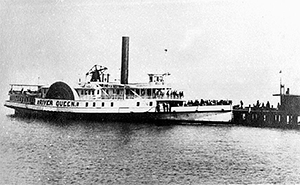The Hampton Roads Peace Conference
The Hampton Roads Conference was an attempt by the two opposing sides during the American Civil War to find peace. It was not successful. By late 1864, casualties were very high for both sides and the war was dragging on with no end in sight. Union troops had scored some significant victories in that year and owned much of the West. In addition, the vaunted Army of Northern Virginia, under the famous Gen. Robert E. Lee, was holed up in Petersburg, kept there by a large Union force under Ulysses S. Grant, who, after yet another round of heavy casualties in attacks on the heavily fortified railroad junction, had settled in for a siege. Francis Blair, an unofficial advisor to President Abraham Lincoln, won Lincoln's permission to meet with Confederate President Jefferson Davis; the two men met twice, in January 1865. Blair floated the idea idea of an armistice that would be punctuated by the two armies' joining together to fight in Mexico, against the regime of the emperor, Maximilian. Davis was intrigued by the suggestion and dispatched Vice-president Alexander Stephens to form a peace commission and arrange a discussion with representatives of the North. Representing the Confederacy at the February 3, 1865, conference were Vice-president Stephens, Assistant Secretary of War John Campbell, and Senator Robert Hunter. Representing the Union were Lincoln and Secretary of State William Seward. 
The meeting, which lasted all of four hours, took place aboard a Union transport ship named the River Queen, which was anchored off the town of Hampton Roads, the site of the ironclad battle between the Monitor and the Merrimack a couple of years before. The two sides had diametrically opposing goals. The Southern representatives wanted the Union to recognize the Confederacy as a sovereign nation. The Northern representatives wanted the opposite, insisting that the Confederacy be dissolved and that all states that had seceded then return to the Union; also, Lincoln and Seward insisted that the South recognize the emancipation of slaves that Lincoln had announced in his Emancipation Proclamation. Lincoln vowed to mandate that Confederate officers and soldiers who surrendered would be treated with honor and respect. At the same time, he was unwilling to discuss any sort Mexico-themed armistice. The conference attendees could find no middle ground and agreed to go their separate ways. Confederate troops did eventually break the siege of Petersburg but only by evacuating the city. Two months after the Hampton Roads Conference, Lee surrendered to Grant and the war was over. |
|
Social Studies for Kids
copyright 2002–2025
David White




